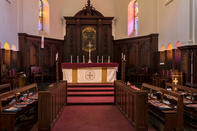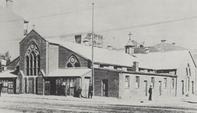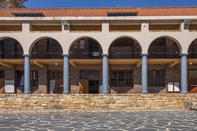Community Withdrawal
The Community of the Resurrection had taken over control of St John’s College in 1906 to save it from closing down. By the end of 1934, with all its material needs taken care of, St John's College had come of age; the Community felt that its task was completed and it was time to move on.

With the withdrawal of the Community, the control of the school reverted to the local Anglican Church in the form of the Johannesburg Diocesan Trustees, whose body appoints the 12-member council of St John's College. Although the principles and the ethos implanted by the Fathers of the Community remained, an era that had lasted 28 years had ended.
Following the departure of the Brethren to their headquarters in Yorkshire, Reverend SH Clarke was appointed in 1935 to succeed Father Runge as headmaster. A brilliant scholar, Clarke had been assistant master at Tonbridge School in Kent before coming to St John's. He stayed until 1954, to become the longest-serving head of the school.
Reverend SH Clarke

SH Clarke was an outstanding educationist and a first-class administrator. His reputation was such that he was appointed to the Joint Matriculation Board after only 18 months in South Africa, and remained a member until his retirement. Not only was he a member of the Board, but he was a very influential one too: largely as a result of his recommendation, the matric syllabus and examination were upgraded radically in 1942, to bring them in line with the Oxford and Cambridge Joint Board's School certificate. This was to be Clarke's outstanding achievement at St John's, for from 1942 until his retirement, St John's averaged a 95-percent pass rate, compared to a national average of 50 per cent.
The new headmaster realised that to achieve the excellence he sought, it was essential to attract and keep good and dedicated teachers. To this end salaries were improved and a programme of building houses for married staff, to be let out at a low rental, was initiated. By the time he retired, seven had been built; today there are 23 houses and seven flats to accommodate teaching staff.
Main Educational Principals

Clarke believed strongly in a few main educational principles - hard work in the classroom, supported by homework; the maintenance of the religious tradition of the community; the promotion of structured reading; a knowledge of chemistry and physics rather than the physical science taught in other schools; the importance of a classical learning; the belief that boarders should make up at least 50 per cent of the enrolment of the school, since it is largely the boarders that give a school its tone; and the streaming (separating into groups) of boys according to their abilities and potential. He was forthright in his views on education, often in strong opposition to the policies of the Transvaal Provincial Administration.
Meanwhile, the school continued to grow. From 500 when Clarke took over, enrolment had risen to 660 towards the end of his term. Compared with the years of previous headmasters; James Nash, Eustace Hill and Charles Runge, little building was carried out, due mainly to a lack of funds and the war and post-war shortages.
New dormitories, staff houses and change-rooms were built, but there was a pressing need for new classrooms and laboratories. The greatest problem facing St John's at the time was overcrowding, a problem that was to be solved only in later years.